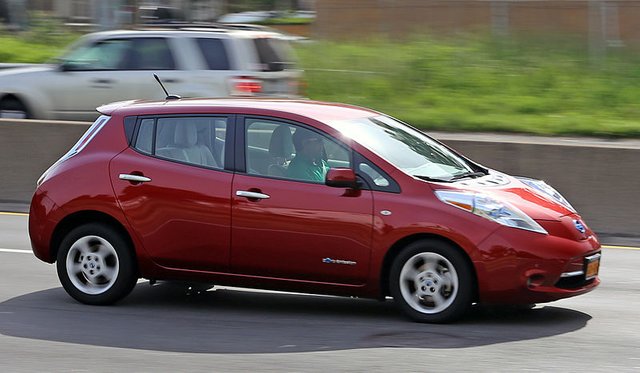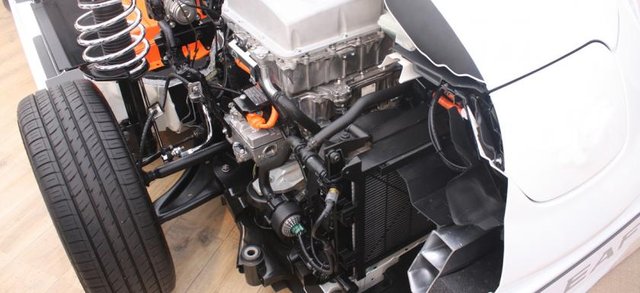How Does Electric Cars Work
Hey guys,it's me again Timgreat i will be writing an article on Electric Cars what they are and how they work and This article is also about the battery in electric cars. For cars with electric motors and internal combustion engines, see hybrid electric vehicle .
Tesla Model S charging at a
Supercharger . Nissan Leaf , as of January 2018, has sold over 300,000 units worldwide.
[1]
An electric car is a plug-in electric automobile that is propelled by one or more electric motors , using energy typically stored in rechargeable batteries.
Since 2008, a renaissance in electric vehicle manufacturing occurred due to advances in batteries, concerns about increasing oil prices , and the desire to reduce greenhouse gas emissions. [2][3] Several national and local governments have established tax credits, subsidies, and other incentives to promote the introduction and now adoption in the mass market of new electric vehicles depending on battery size, their all-electric range and purchase price. The current maximum tax credit allowed by the US Government is US$7,500 per car. [4] Compared with cars with internal combustion engine vehicles, electric cars are quieter and have no tailpipe emissions, and in most places, with a few exceptions, lower emissions in general. [5]
Charging an electric car can be done at a variety of charging stations , these charging stations can be installed in both houses and public areas. [6] The two best selling electric vehicles, the Nissan Leaf, and the Tesla Model S, have ranges reaching 151 miles (243 km) and, 335 miles (539 km) respectively. [7][8]
As of June 2017, there are over 2 million electric cars in use around the world. [9] The Nissan Leaf is the best-selling highway-capable electric car ever, with over 300,000 units sold globally by January 2018. [1] Ranking second is the Tesla Model S with almost 213,000 units sold worldwide through December 2017.
Terminology
Electric cars are a variety of electric vehicle (EV). The term "electric vehicle" refers to any vehicle that uses electric motors for propulsion, while "electric car" generally refers to highway-capable
automobiles powered by electricity. Low-speed electric vehicles, classified as neighborhood electric vehicles (NEVs) in the United States, [11] and as electric motorised quadricycles in Europe,
[12] are plug-in electric-powered microcars or city cars with limitations in terms of weight, power and maximum speed that are allowed to travel on public roads and city streets up to a certain posted speed limit, which varies by country.
While an electric car's power source is not explicitly an on-board battery, electric cars with motors powered by other energy sources are generally referred to by a different name. An electric car carrying solar panels to power it is a
solar car , and an electric car powered by a gasoline generator is a form of hybrid car . Thus, an electric car that derives its power from an on-board battery pack is a form of battery electric vehicle (BEV). Most often, the term "electric car" is used to refer to battery electric vehicles .
How it Works
Battery electric vehicles, or BEVs, use electricity stored in a battery pack to power an electric motor and turn the wheels. When depleted, the batteries are recharged using grid electricity, either from a wall socket or a dedicated charging unit. ... The amount of pollution produced depends on how the electricity is made
. Since they don’t run on gasoline or diesel and are powered entirely by electricity, battery electric cars and trucks are considered “all-electric” vehicles.
When driven, BEVs don’t produce tailpipe pollution—they don’t even have a tailpipe. However, the electricity they use may produce heat-trapping gases and other pollution at the source of its generation or in the extraction of fossil fuels. The amount of pollution produced depends on how the electricity is made. In the United States, battery electric cars charged off the dirtiest coal-dominated grid still produce less pollution than their gasoline-powered counterparts. BEVs powered by renewable energy sources like wind or solar are virtually emission-free.
Not using gasoline or diesel also means that battery electric cars are significantly cheaper to fuel than conventional vehicles. Exact comparisons depend on the vehicle model and fuel prices, but driving a BEV can save drivers
over $1,000 annually in gasoline money.
2009 2016
New data show EVs continue to get cleaner. See our blog
Battery electric vehicle features
Like other electric and hybrid-electric vehicles, BEVs minimize wasted energy by turning the car off when stopped (“ idle-off ”) and by charging the battery when braking (“ regenerative braking ”). Electric motors are also inherently more energy-efficient than gasoline or diesel engines.
Battery electric cars run entirely on electricity and can be significantly cleaner than gas-powered vehicles.
Battery electric cars have the added benefit of home recharging. A 240-volt outlet, similar to those used for clothes dryers, can charge a vehicle overnight. Fully-charged, most battery electric cars have a driving range of between 70 to 100 miles, well within the day-to-day range requirements of most Americans, though some BEVs can go up to 265 miles on a single charge. An increasing number of public and workplace charging stations provide added charging capacity.
More subjectively, many drivers appreciate the driving experience provided by all-electric cars. Electric motors generate near-instant torque, or turning-force, while the torque of internal combustion engines increases in tandem with the engine’s revolutions (RPM). This means that BEVs have extremely fast acceleration and a “light” or “zippy” feel compared to conventional cars and trucks.
Differences between battery electric cars and other EVs
Plug-in hybrid electric vehicles have both an electric motor and a conventional gasoline or diesel engine. Compared to a battery electric vehicle, this extends the total driving range but lowers the all-electric range. Conventional hybrids , which can’t be plugged in, aren’t considered electric vehicles. Learn more about
how plug-in vehicles work >
Fuel cell electric vehicles convert hydrogen gas into electricity to power an electric motor and battery. Fuel cell vehicles are a relatively new technology in passenger vehicles, but have a substantial carbon-cutting role to play alongside other all-electric vehicles. Learn more about how fuel cells and fuel cell vehicles work >
Learn more about electric vehicle technology here , including its potential as a nationwide oil-saving solution.
Conclusion:
Battery electric vehicles, or BEVs, use electricity stored in a battery pack to power an electric motor and turn the wheels. When depleted, the batteries are recharged using grid electricity, either from a wall socket or a dedicated charging unit. ... The amount of pollution produced depends on how the electricity is made
Reference:
°Electric Cars
°How Electric Cars Work
°Personal knowledge and notes
External links:
•https://www.ucsusa.org/clean-vehicles/electric-vehicles/how-do-battery-electric-cars-work
https://en.m.wikipedia.org/wiki/Electric_car


This file is licensed under the Creative Commons Attribution-Share Alike 3.0 Unported license.
•
Note: Images used in this article are CC0 licensed and were properly sourced. Those credited to @timgreat are originals.
All external links in the article are for better understanding of anything confusing. All credits to their individual authors.
Thanks for reading. All arguments, debates, additions and questions, should be dropped below as a comment
I Am TimGreat